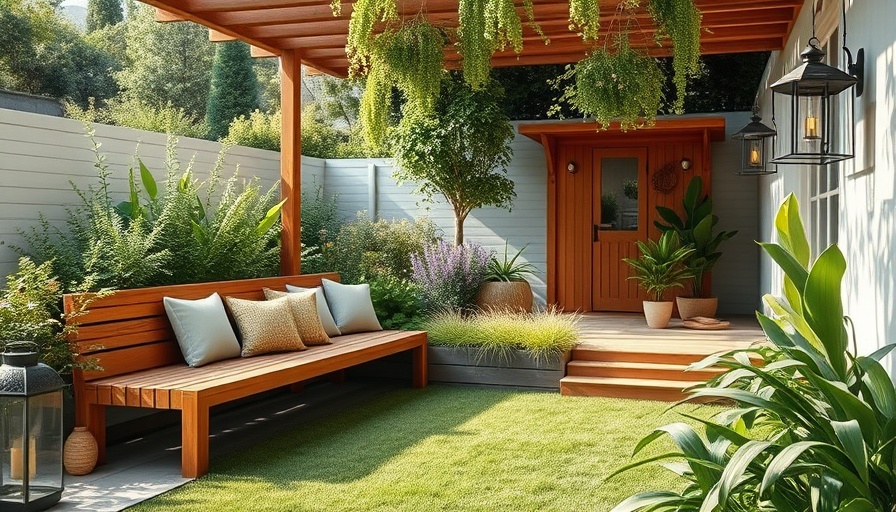
Transform Your Outdoor Space: A Journey Into Low-Maintenance Modern Gardening
Gardening can be a blissful escape, a sanctuary where you relax, throw gatherings, and connect with nature. But what happens when the lush space you've cherished turns into an unmanageable chore? Regular maintenance and changing elements can lead to challenging situations—overgrown plants, unsightly weeds, and faded beauty. In our quest for a revitalized landscape, we explore the transformation of a garden from a once-great lawn into a vibrant and functional modern oasis. With strategic design choices, careful planning, and a touch of creativity, your garden can be reimagined to reflect your lifestyle with minimal upkeep required.
In 'How To Make A Low-Maintenance Modern Garden | Great Home Ideas', the discussion dives into essential garden renovation topics, exploring key insights that sparked deeper analysis on our end.
Understanding Garden Design: Creating Clarity and Function
At the heart of a successful garden rejuvenation is a clear design. Take a step back and envision where the seating and garden beds should lie. By well-defining segments of your garden, you not only create visual interest but also instill functionality within the space. For example, using aluminum edging can introduce gentle curves that break the rigid structure of typical garden layouts, inviting visitors into the greenery.
The Magic of Functional Features: Gabion Baskets and Seating Spaces
One of the standout features often overlooked in garden design is the addition of functional products like gabion baskets. By filling these versatile baskets with river pebbles, not only do you introduce an artistic flair, but you also create durable benches—perfect for enjoying your garden view. The combination of aesthetics and utility can elevate the overall experience, making your garden not just a patch of greenery but a curated experience.
Plants That Thrive in Modern Gardens: Choosing Wisely
When it comes to planting flowers and foliage, opting for a blend of low-maintenance varieties is key. For instance, integrating clumping bamboo not only provides height and privacy but also offers a beautiful backdrop. Adding plants like succulents, colorful natives, and vibrant flowering varieties can bring life to sunny spots, while shade-loving species can gracefully flourish in dim areas. The right selections can significantly lessen maintenance efforts while keeping your garden flourishing.
Elevate Your Space: Mulching and Pruning Techniques
Effective mulching can protect your soil, suppress unwanted weeds, and retain moisture—an essential tactic for any sustainable backyard garden. Combining mulch with a strategic watering schedule helps maintain the health of your plants, allowing for vigorous growth while reducing the frequency of care you must provide. Additionally, the practice of pruning trees not only enhances their health but also contributes to the overall polish of your landscape.
Designing Functionality: Pathways and Irrigation Systems
Enhancing your garden means more than just aesthetics; functionality must strike a balance. Adding clear pathways keeps your garden navigable, allowing you to admire different elements without trampling on delicate plants. Proper irrigation systems such as drip irrigation can minimize water waste while ensuring that each plant receives adequate hydration. This way, maintaining your botanical sanctuary feels less like a routinely laborious chore.
Inspiring the Community: Your Garden as a Reflection
Beyond individual gardens, the broader impact of well-designed communal gardens cannot be overstated. Transforming shared spaces through sustainable gardening can help foster relationships, build community pride, and even enhance local biodiversity. As we cultivate our own gardens, we indirectly inspire neighbors to invest in their spaces, sparking real change within our enclaves.
In conclusion, maintaining a garden doesn’t have to involve tedious labor, but rather can be a delightful engagement with nature when done right. By utilizing practical design strategies, purposeful plant selection, and smart maintenance techniques, you can achieve a beautiful low-maintenance modern garden that serves as an inviting retreat for you, your family, and friends. And as you embark on this journey, embrace the beauty of creation and connection with your surroundings.
 Add Row
Add Row  Add
Add 




Write A Comment